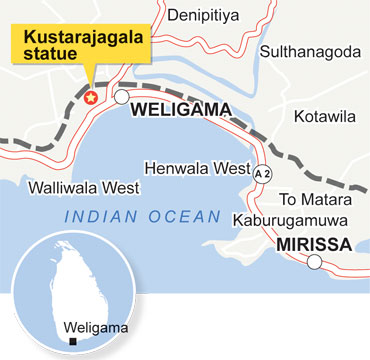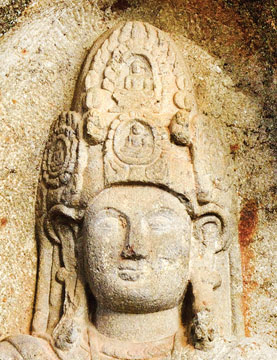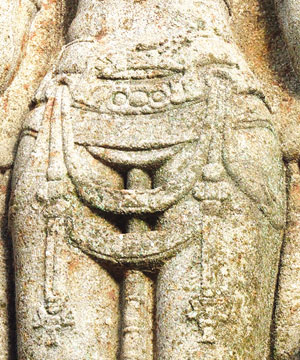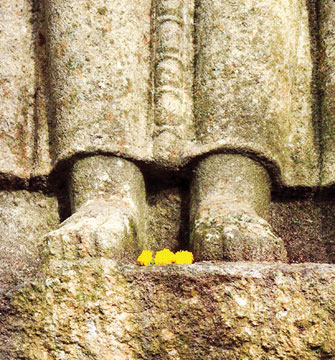|
Kustarajagala
Homage in rock to a Bodhisatva
Story and pictures by Mahil Wijesinghe
Having visited Rumassala, which we featured last week, we headed
toward the coastal fishing town of Weligama, through delightful seaside
resorts. The placid bay of Weligama is located 30 kilometers from Galle.
The seascape is filled with ubiquitous stilt fishermen’s single poles
with a cross bar to catch small fish in chest-deep water on the beach.
This is a visual treat and one of the most photographed scenes in the
world. Unfortunately, being a Poya day, we couldn’t see even a single
fisherman and we really missed the most picturesque sight on the
Weligama sandy beach.
|

The magnificent rock hewn statue of Kustarajagala |
Though Weligama is seen as a drowsy small sea town today, in colonial
period it was a highly prosperous centre of foreign trade. The 16th
century lace-making craft which was introduced by Portuguese still
remains in some parts of the coastal area of Weligama. The only remnants
of the colonial period in Weligama, I managed to spot was a few old
buildings here and there with tall columns with some lattice work.
 The magnificent ancient Kustarajagala archaeological site is located
within the hustle and bustle of the Weligama town area in proximity to
the Aggrabodhi Vihara off the old Colombo road. Urbanization has
engulfed the surrounding areas of Kustarajagala site which is confined
to cramped small plot of land today. The magnificent ancient Kustarajagala archaeological site is located
within the hustle and bustle of the Weligama town area in proximity to
the Aggrabodhi Vihara off the old Colombo road. Urbanization has
engulfed the surrounding areas of Kustarajagala site which is confined
to cramped small plot of land today.
The houses on every side and Matara-Colombo railway line is just
behind the site. A huge playground lies in front of this sacred site
where children play cricket and stray cows graze here and there.
Although the pace of time has overtaken this sacred place, it still
retains its character as a place of peace and tranquility.
The Kustarajagala rock cut statue about 15 feet in height stands on
an isolated rock. We got the feeling that time has rushed past leaving
the statue forgotten. Carved in a tombstone-shaped niche in a large rock
facing the east, folklore is the only source that can shed some light on
this figure’s past.
An intricately carved and elaborately dressed splendid statue of
Bodhisattva is set deep into the rock. It lies in the shade of
overhanging Bo-tree. When I stepped in to the site, the morning rays of
the sunlight were flickering through the branches of the massive
Bo-tree.
Incurable skin disease
Perhaps, a huge rock boulder has been sliced in two to create this
work. The other half lies just opposite, wrapped within the roots of an
ancient Bo-tree. Since the statue was carved out into the rock at a
somewhat higher elevation, we can view it above the eye level about
eight feet from the ground. After climbing the opposite rock, we came up
to eye level with the statue. From this point the whole statue seems
very different and every detail becomes so clear. Then we realized the
massive scale of the statue.
|

The elaborately carved head-dress of Kustarajagala statue |
|

Necklaces adorn the neck |
|

The close-up of the waist of the statue with carved motifs |
|

The feet of the statue |
Known as Kustaraja, the statue was created between 7-8th century
according to the notice board erected here by the Department of
Archaeology. There are various legends associated with the name and the
construction of this statue. The favorite among them seems to be that it
is an image of an ancient king who suffered from an incurable skin
disease. Legend has it that it was on this spot that the king was cured
of his sickness and it was he who had made the statue.
The ancient chronicle records that King Aggrabodhi IV (667-683AD),
suffered from an incurable disease and had got this sculpture made under
his patronage. Since Aggrabodhi IV lived in Ruhuna for a long time he
may indeed have constructed this statue.
Intricately carved statues
Looking closely at the details of this rock heaven statue, we came
across several features. The statue is heavily draped in elaborate
ornaments and clothes. The head dress too is very elaborately designed
with four figures of Buddha carved on three sides of it. Many necklaces
adorn the neck. Parts of the head dress touch the shoulders. Perhaps,
this is one of the most beautiful and intricately carved statues in Sri
Lanka suggestive of the influence of Mahayana Buddhism in the country in
the 7-8th centuries.
Tragically, someone has attempted to dig out an area between the
chest and the waist of this statue removing a piece of rock which
contained an elaborately carved ornamental design across the statue.
Several similar marks are found in the head-dress of the
Kustarajagala statue which is also believed to represent a Bodhisattva.
Avalokitesvara is assigned a higher status than Maitreya by the
Mahayanists. He is identified as Natha Deviyo and is said to represent
the influence of Hindu pantheism in Sri Lanka. The left hand of the
statue’s ring finger and the middle finger are bent to touch the palm of
the hand. This Mudra (pose) is believed to signify a beckoning to
devotees for a blessing.
Saviour of mankind
Nearby, the Aggrabodhi Rajamaha Vihara is one of the first 32
saplings of the Sri Maha Bodhiya at Anuradhapura. It is also speculated
that this Vihara was called Aggrabodhi since it was constructed under
the patronage of King Aggrabodhi IV (667-683AD). The Kustarajagala
statue is said to have been part of this temple at the time, though some
others it was part of an old Avalokitesvara-Natha temple that used to
stand on this site.
|

The tomb within the premises believed to be the final
resting place of a European |
This tallies with the doctrine of Mahayana Buddhism, as the
Avalokitesvara was the saviour of mankind and the healer of the sick. So
Kustarajagala may belong to the Mahayana sect, long since defunct here
and considered heretic. In Ruhuna, we found several other Mahayana sites
where similar Avalokitesvara Bodhisatva statues exist - Situlpahuwa,
deep in Yala National Park, Maligawila at Okkampitiya and Buduruwagala
rock carvings at Wellawaya are examples.
The Kustarajagala statue is the most outstanding relic today of a
period during which Mahayana and Tantric Buddhism held sway in Sri
Lanka. When the statue was completed is not known and this lack of any
detailed history may be due to the statue’s Mahayana origins.
European tomb
The competition between Mahayana and Theravada became a veritable war
at one point in Sri Lanka’s history. Finally, the original sect of
Theravada prevailed. With time, memories of Mahayanism faded away
completely. Most Sri Lankans today consider Mahayanism an exclusively
foreign sect.
However, devotees still come to the Kustarajagala statue to worship
and pray for relief from diseases - they regard the statue as a
Mahayanist Bodhisattva who is considered a healing deity.
In front the Kustarajagala statue just a few feet away, lies a tomb
of a European. Some believe it may belong to an engineer who came to
build the railway track. Why this tomb is erected here is not known and
mysterious, but its details carved out on a granite plaque are still
readable. It says “In loving memory of Thomas H.D. Gadder, Born 25 Aug.
1825, Died 10 Aug. 1907, Jesus is our Peace”.
If you find some extra time on your hands on a trip to Weligama, do
not forget to see this statue. |

